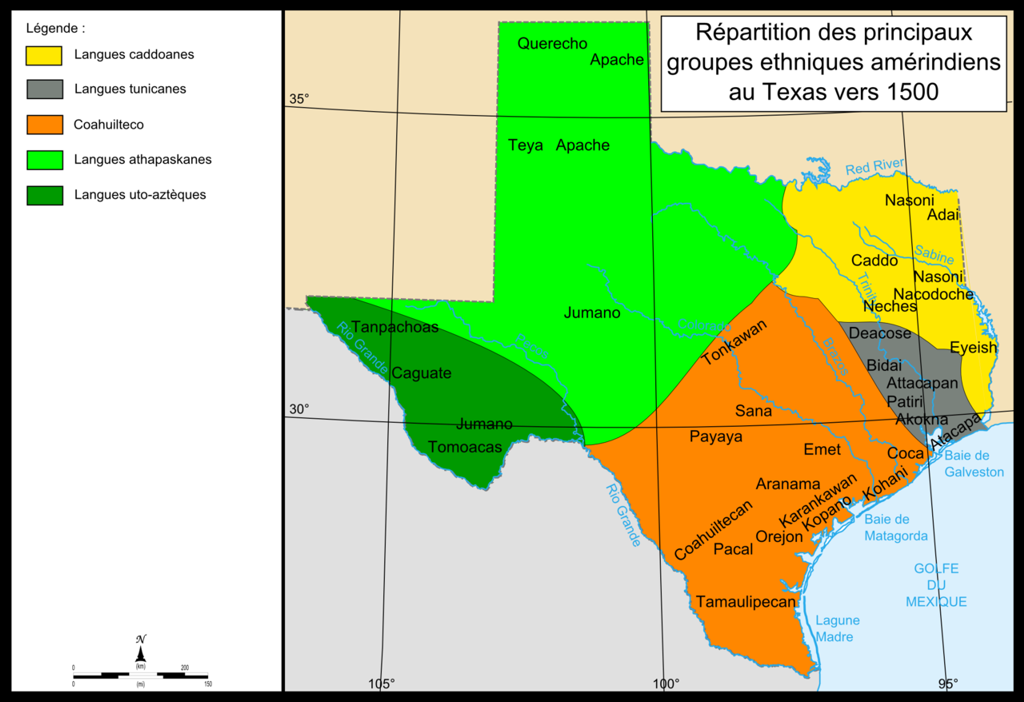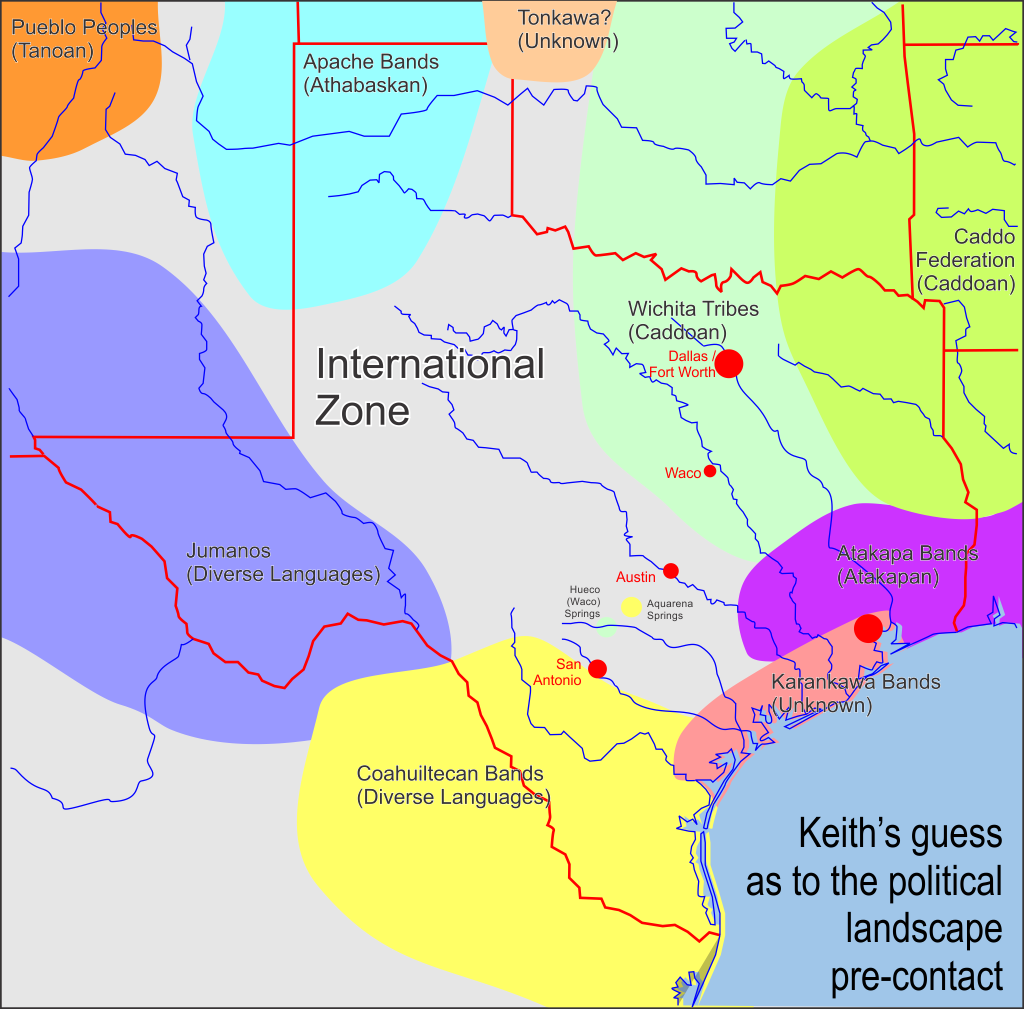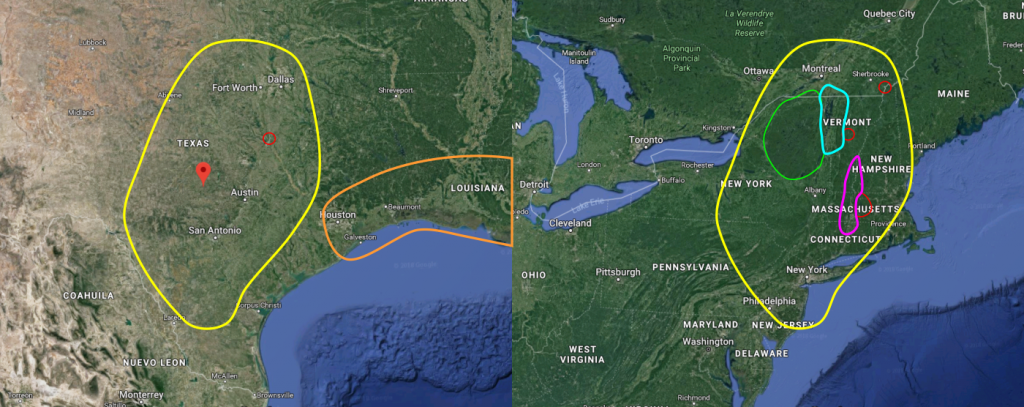In researching the Texas Problem, and the seemingly contradictory Waco Problem, one significant question arises- who lived here before Europeans?
Specifically, which group or groups were indigenous- having inhabited Central Texas for the longest time before the Spanish and Anglos arrived?
Casual Internet searching delivers an absolute mess, such as this map on Wikipedia:

Digging deeper, there are a large number of errors with this map, which purports to describe the situation in Texas around the year 1500.
The Apache were present in the Texas Panhandle as nomadic bands by 1500, having migrated from the northwest in prior centuries. The Tonkawa, incorrectly represented here as Coahuiltecan, are now thought to have lived in much the same area as the Apache until forced out by the Commanche around the turn of the 18th Century.
The Jumano, upon further review, seem to have been a cross-cultural melting pot of people from various tribes who formed a diverse trading and diplomatic society at the meeting point of numerous linguistic traditions.
Other maps represent Comancheria as having been in existence pre-contact. However, there’s significant evidence that the Commanche were still living in the vicinity of Montana in 1500 and did not venture south until acquiring horses by trade after the 1680 Pueblo Revolt in New Mexico.
Part of the issue confusing pre-contact maps is the tendency, by Anglos and Spaniards to confuse bands, tribes, and nations. Imagine if a traveler met a group identified as “Round Rock” or “Austin” and decided that Austin was a great city of the Round Rock nation.
Students of European history should know better, as it was not that long ago when a single barony might sway back and forth between two, three, or even four kingdoms, any of which might later be considered counties or duchies in a still-larger kingdom.
The same applies with native peoples, who might share kinship and political cooperation with a sizeable number of other bands, collectively a tribe, and a group of tribes, sharing a common linguistic heritage and a more or less peaceful coexistence might be considered a nation.
To be fair, all of these distinctions are muddy, both for native peoples and European-style nations. For the sake of not bogging down too much in technicalities I am concerning myself with native nations in the sense of large linguistic groups who were allied with each other. That said, internecine conflict still occurred within nations, as it did between villages in Europe and still sometimes does here in the U.S.
This is the map I come up with:

As you can see, there is a huge area that is “international”. There were definitely important sites linked to various nations within that zone- for instance Aquarena Springs which is sacred to certain Coahuiltecan bands and Hueco Springs to the south, which by some accounts was used by people related to the Waco village at, well, Waco.
Similarly, the Jumano and Coahuiltecan areas seem to have been populated by a number of different peoples who spoke different languages. While the Coahuiltecan bands seem to have shared similarities in diet and lifestyle, historians are unsure about Jumanos. In some cases they are described as settled farmers and in other cases as nomadic hunters.
It is entirely possible that the Jumanos region was actually much larger and included both settled peoples and nomads who traded extensively. We have written accounts of the Apache and Pueblo peoples trading this way, and of Apache bands camping near the Pueblos in colder months.
Likewise, the Tonkawa probably moved about in the “international” zone until the Comanches forced them and the Apaches south around the turn of the 18th Century.
If I am even remotely correct, the indigenous peoples in the area of concern were a combination of nomadic Coahuiltecan bands and villages of Wichita-related folks like those who lived at Waco.

Survivors of the Coahuiltecan peoples remain a part of the local population, often considered “Mexican” because their ancestors were forced to speak Spanish and to convert to Catholicism.
The Wichita bands were largely driven out of the area in the early 1800s by both Anglos and eastern native peoples being pushed into the area by Anglos. The main village at Waco was apparently deserted sometime in the 1830s after being sacked by another native people- either the Cherokee or Comanche.
By the 1870s, almost all the free native peoples in Texas were being forced onto reservations in Oklahoma. This included the Wichita-speaking tribes, their Caddo cousins to the east, the Tonkawa, and various other pockets that had survived earlier conquests.
Given the decentralized, nomadic lifestyle of the Coahuiltecan bands versus the more settled agriculture of the Wichita-speakers, I’m inclined to focus my research on the latter. I suspect that whatever happened at Waco in the 1830s is somehow connected to the larger issue I’m trying to solve.
-In Deos Confidimus
